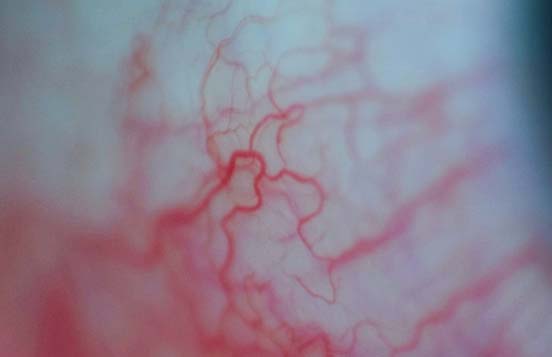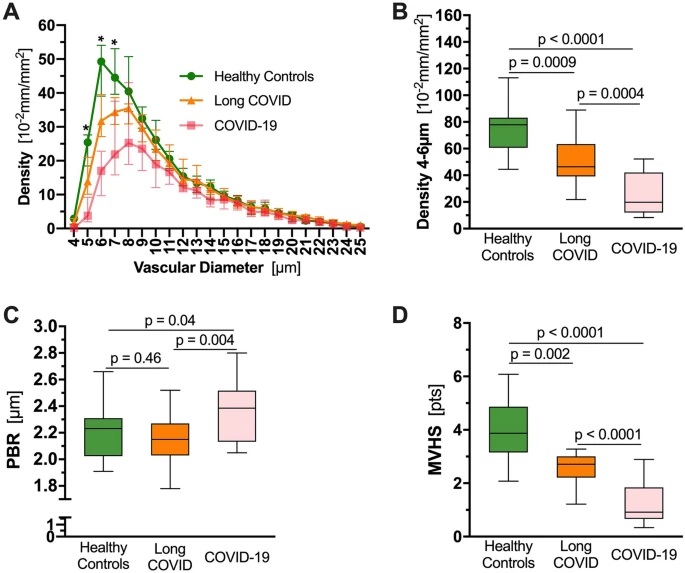BREAKING! German Study Shows Persistent Capillary Rarefication (A Reduction In Vascular Density) Even 18 Months After COVID-19 Infection!
Source: Medical News - COVID-19 Research Aug 12, 2022 2 years, 8 months, 1 week, 5 days, 22 hours, 46 minutes ago
COVID-19 Research: A new study by German researchers from University Hospital Münster has alarmingly found that that SARS-CoV-2 virus leaves a persistent capillary rarefication (a reduction in vascular density) even 18 months after infection!

Capillary rarefaction is a hallmark of fibrotic disease and reduces blood perfusion and oxygen delivery. Alterations in intracellular pO2 have profound effects on cellular metabolism, proliferation, differentiation, tissue-specific function and even transcriptional regulation of certain genes. It can lead to organ damage and a variety of health issues, some with even fatal outcomes!
Even more concerning is to what extent is the damage and whether the observed damage might be reversible remains unclear.
Numerous studies have already highlighted COVID-19 as a multisystemic vascular disease. Up to 60% of the patients suffer from long-term sequelae and persistent symptoms even 6 months after the initial infection.
This new prospective, observational study included 58 participants, 27 of whom were long COVID patients with persistent symptoms > 12 weeks after recovery from PCR-confirmed SARS-CoV-2 infection. Fifteen healthy volunteers and a historical cohort of critically ill COVID-19 patients (n = 16) served as controls. All participants underwent sublingual videomicroscopy using sidestream dark field imaging. A newly developed version of Glycocheck™ software was used to quantify vascular density, perfused boundary region (PBR-an inverse variable of endothelial glycocalyx dimensions), red blood cell velocity (VRBC) and the microvascular health score (MVHS™) in sublingual microvessels with diameters 4–25 µm.
Though dimensions of the glycocalyx were comparable to those of healthy controls, a µm-precise analysis showed a significant decrease of vascular density, that exclusively affected very small capillaries (D5: − 45.16%; D6: − 35.60%; D7: − 22.79%). Plotting VRBC of capillaries and feed vessels showed that the number of capillaries perfused in long COVID patients was comparable to that of critically ill COVID-19 patients and did not respond adequately to local variations of tissue metabolic demand. MVHS was markedly reduced in the long COVID cohort (healthy 3.87 vs. long COVID 2.72 points; p = 0.002).
The
COVID-19 Research findings strongly suggest that COVID-19 leaves a persistent capillary rarefication even 18 months after infection. Whether, to what extent, and when the observed damage might be reversible remains unclear.
The study findings were published in the peer reviewed journal: Angiogenesis. (By Springer)
https://link.springer.com/article/10.1007/s10456-022-09850-9
The German vivo study is the first to address the microvasculature of long COVID individuals in a detailed, diameter class-wise manner. The number of small capillaries, but not of the supply vessels, were markedly reduced, very similar to the pattern found during severe COVID-19 infection.
The study findings also showed that capillary recruitment of COVID long-term patients remains significantly redu
ced.
The study data showed that while healthy controls succeed in maintaining a constant capillary VRBC (almost horizontal slope), long COVID patients as well as acute COVID-19 patients fail to do so (steeper slopes). This finding reflects a persistent fixed number of perfused capillaries, which is insensitive to local tissue variations of metabolic demand.
The study team lead by Dr Michael Mohr and Dr Alexandros Rovas from the Department of Medicine at University Hospital Münster told Thailand
Medical News, “To what extent this capillary rarefication is mechanical or/and functional remains unclear.”
A past study revealed common clotting pathologies in plasma of acute and long COVID patients, further supporting the existence of persistent microthrombi.
https://pubmed.ncbi.nlm.nih.gov/34425843/
Aside from that, an insufficient recovery of the initial inflammation accompanied by persistent immunological abnormalities might also be responsible for the observed capillary impairment.
https://pubmed.ncbi.nlm.nih.gov/35105985/
 Microvascular phenotyping by quantitative sublingual video microscopy. A Median and IQR values of vascular density of healthy controls (green), and long-haul COVID-19 (orange) patients based on the diameter class from 4 to 25 µm. A historical cohort of hospitalized COVID-19 patients (pink) is shown for reference. *q < 0.05, **q < 0.01, ***q < 0.001. B–D Boxplots of B capillary density (D4–6 µm) and C PBR4–25 µm and D MVHS™ of healthy controls (green), long-haul COVID individuals (orange), COVID-19 patients (pink). COVID-19 Coronavirus disease 2019, CR capillary recruitment, D diameter, PBR perfused boundary region, RBC red blood cell, VRBC red blood cell velocity, MVHS™ microvascular health score
Microvascular phenotyping by quantitative sublingual video microscopy. A Median and IQR values of vascular density of healthy controls (green), and long-haul COVID-19 (orange) patients based on the diameter class from 4 to 25 µm. A historical cohort of hospitalized COVID-19 patients (pink) is shown for reference. *q < 0.05, **q < 0.01, ***q < 0.001. B–D Boxplots of B capillary density (D4–6 µm) and C PBR4–25 µm and D MVHS™ of healthy controls (green), long-haul COVID individuals (orange), COVID-19 patients (pink). COVID-19 Coronavirus disease 2019, CR capillary recruitment, D diameter, PBR perfused boundary region, RBC red blood cell, VRBC red blood cell velocity, MVHS™ microvascular health score
Numerous past studies focusing on the pulmonary, exertional and myocardial microcirculation of long COVID individuals showed local impairment of the microcirculation.
https://pubmed.ncbi.nlm.nih.gov/33217366/
https://www.ncbi.nlm.nih.gov/pmc/articles/PMC8886771/
https://pubmed.ncbi.nlm.nih.gov/34341436/
The study findings from this German research complement these findings and point to a systemic and long-lasting capillary rarefication.
The study findings could possibly explain the functional impairment observed in long COVID syndrome.
A typical subtle but exciting feature of the long-haul COVID group is, that the RBC velocities are the highest in the long COVID cohort (indicated by parallel shift of the slope to the upper right).
The study team speculates that this finding could represent a compensatory mechanism to meet metabolic demands. Considering that the measurements were taken at physical rest, it is quite conceivable that this presumed compensatory mechanism is exhausted more quickly during exertion than in healthy individuals, possibly explaining long COVID symptoms.
The study team previously were able to present data on persistent exertional impairment caused by (micro-) circulatory reduction of the oxygen pulse during sequential, bicycle cardiopulmonary exercise test.
https://www.ncbi.nlm.nih.gov/pmc/articles/PMC8886771/
Another past study reported a significant microvascular and endothelial dysfunction in a post-COVID cohort, evaluated by finger thermal monitoring after occlusion and reperfusion of the hand.
https://pubmed.ncbi.nlm.nih.gov/34917659/
Long COVID individuals showed a higher endothelial quality index and a slower response to the reperfusion phase. This study finding was partially reversed after oral intake of sulodexide, a highly purified mixture of glycosaminoglycans, that includes fast-moving heparin and dermatan sulfate.
https://pubmed.ncbi.nlm.nih.gov/35647070/
The German study findings imply that long COVID individuals respond inadequately to local variations of tissue metabolic demand. Therefore, it is intriguing to speculate, that this delayed response after reperfusion might be the functional result of the observed capillary rarefication and the impaired capillary recruitment of the remaining capillaries in the long COVID individuals.
Microvascular impairment appears to play a crucial role in the pathophysiology of both COVID-19 and post-COVID sequelae [2, 23].
https://link.springer.com/article/10.1007/s10456-021-09805-6
https://academic.oup.com/cardiovascres/article/117/14/2705/6370961?login=false
The study findings strongly suggest that COVID-19 leaves a persistent capillary rarefication even 18 months after infection. Whether, to what extent, and when the observed damage might be reversible remains unclear. If capillary rarefaction were to persist, additional cardiovascular disease (e.g., diabetes, hypertension) will be less well compensated and become symptomatic much earlier. It therefore seems important to understand the mechanisms of capillary rarefication in long COVID in detail.
For the latest
COVID-19 Research, keep on logging to Thailand
Medical News.

